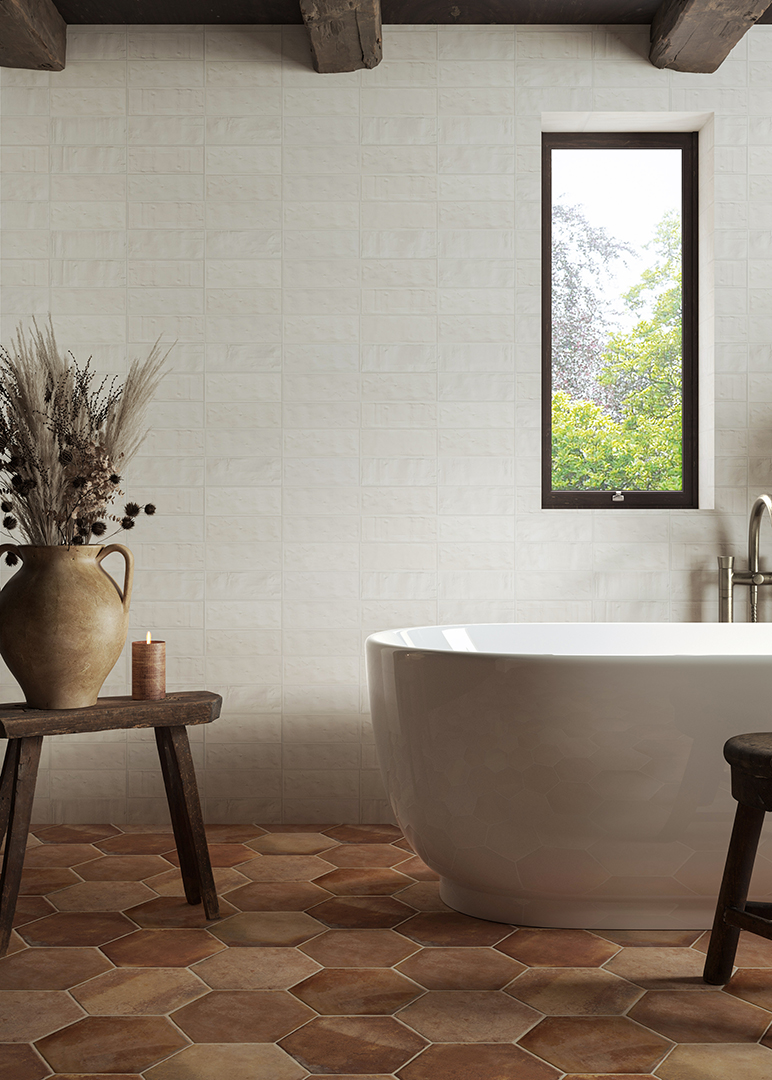A Guide to Terracotta Tiles
Terracotta tiles have been around for thousands of years, originating from ancient Egypt, before becoming widely used across the Mediterranean. These small yet beautiful tiles have remained a favourite in interiors; loved for their authentic, warm, and timeless appeal. With terracotta tiles trending in the last few years, many homeowners are choosing these tiles with varying hues of red and orange across kitchen floors, utilities, bathrooms, and hallway tiles. Read the guide on terracotta tiles.


What are terracotta tiles made of?
The word ‘terracotta’ in Italian is translated as ‘baked earth’; terracotta tiles are made of clay with a reddish brown hue that is fired to an extremely high temperature, resulting in a warm toned tile with a rustic appearance. The process involves the terracotta clay being prepped, shaped, dried, and fired. The tiles can then be glazed to achieve different colours or finishes or left unglazed for a natural earth ware look.
Different tile sizes of terracotta flooring
Terracotta flooring is popular for its versatility and uses, with many different tile sizes and formats available. Traditionally, terracotta tiles have been known as smaller square tiles, however there many other formats such as brick and hexagon. Brick or metro tile formats can be laid in various patterns, from the popular herringbone tile pattern, to stacked or brick bond. Read more about 10 ways to lay metro tiles. Hexagon terracotta tiles are also a wonderful alternative to the traditional square, adding an understated decorative touch to any space.
With state of the art machinery constantly being developed in the porcelain industry, this has opened up a whole realm of tiling options that look just like the real thing. Terracotta effect tiles are an authentic replica of popular terracotta floor tiles, offering a hardwearing material that doesn’t require sealing and is easy to maintain. A porcelain tile is a man-made product that combines kaolin clay, finely ground sand, and feldspar. The clay mixture is fired to an extremely high temperature, resulting in a very dense tile that benefits from a low water absorption rate. The benefits of choosing terracotta effect tiles includes their realistic nature and beauty, diversity of sizes and shades and their low maintenance.
Terracotta tiles are known for their earthy and rich colour palette. When choosing terracotta flooring, many ask what colour goes with terracotta best. There are a few approaches you can take with the shades you choose; whether you want to contrast, complement, or soften the scheme. A favourite is to contrast with an opposite hue on the colour wheel, so greens or blues will work beautifully against the red and orange tones of terracotta. This could be a muted green such as Farrow & Ball ‘French Grey’ or darker such as Farrow & Ball ‘Beverly’. To soften the warm shades of terracotta, an off white or neutral colour can work well and also help bring in a light and airy feel. If you’re wanting to embrace the shade of terracotta, then earthy colours such as browns or reds like Farrow & Ball ‘Picture Gallery Red’ are perfect to colour drench a room.
Do terracotta tiles need sealing?
Natural terracotta tiles are porous and will therefore require sealing, however, a big benefit of terracotta effect tiles is that they do not need sealing, thanks to their strong porcelain body and hardwearing glazed surface. A porcelain tile is a man-made product that combines kaolin clay, finely ground sand, and feldspar. The clay mixture is fired to an extremely high temperature, resulting in a very dense tile that benefits from a low water absorption rate.
How to clean terracotta tiles?
How to clean terracotta tiles? When it comes to cleaning terracotta tiles, it is important to vacuum or sweep any dirt or dust when the surface is dry. Natural terracotta flooring will require sealing and resealing, its worth spot cleaning any spillage as and when they occur. You can also occasionally mop using a stone friendly cleaner diluted in warm water, such as Lithofin Wash & Clean. Never use any acidic or abrasive cleaners for natural terracotta as this may strip the sealant on the tiles.
Terracotta effect porcelain tiles are very easy to clean and maintain. We recommend the same steps of vacuuming and sweeping any dirt or dust when the tiles are dry, as well as occasional mopping. Porcelain does not need sealing and is much more resistant to staining. Most household cleaners can be used, but we recommend using a porcelain friendly cleaner such as Lithofin Conditioning Cleaner.
What colour grout to use with terracotta tiles?
We always say the grout colour you choose is ultimately up to you, however, we would recommend choosing a colour lighter or similar to the tone of the tiles for the best authentic look. If the grout is darker than the tiles themselves, this can give the appearance of ‘picture framing’ the tiles with the grout lines being too prominent and dark. With terracotta tiles being reds and browns, we recommend any grout colours on the warmer side, rather than cooler tones of off white or grey. Kerakoll Color grout is available in various complementing shades.











